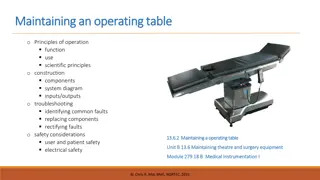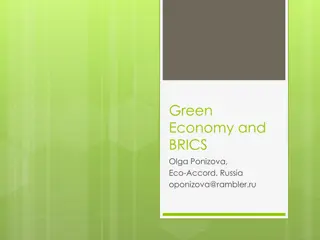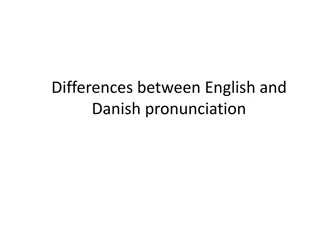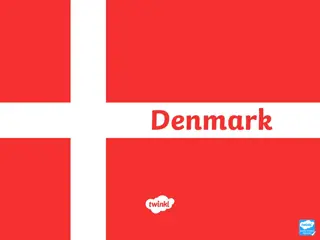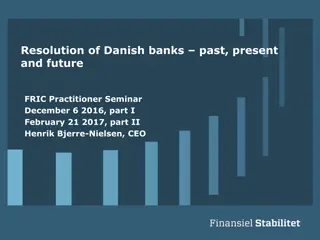
Decomposition of Income and GDP Trends in High-Income OECD Countries
Explore the decomposition of income per capita and GDP trends in selected high-income OECD countries relative to the USA. Gain insights into factors such as employment ratios, working hours, and value added per hour worked. Discover how different countries compare in terms of economic indicators.
Download Presentation

Please find below an Image/Link to download the presentation.
The content on the website is provided AS IS for your information and personal use only. It may not be sold, licensed, or shared on other websites without obtaining consent from the author. If you encounter any issues during the download, it is possible that the publisher has removed the file from their server.
You are allowed to download the files provided on this website for personal or commercial use, subject to the condition that they are used lawfully. All files are the property of their respective owners.
The content on the website is provided AS IS for your information and personal use only. It may not be sold, licensed, or shared on other websites without obtaining consent from the author.
E N D
Presentation Transcript
Table 1.1 Table 1.1: Decomposition of income per capita for selected high-income OECD countries relative to the USA, 2019 Income per capita 1.86 1.36 1.09 1.03 1.00 0.92 0.92 0.91 0.90 0.86 0.86 0.86 0.84 0.79 Employment/ population ratio 0.99 0.99 1.15 1.06 1.00 1.03 1.18 1.08 1.02 1.06 1.07 1.05 0.88 0.97 Annual working hours 0.85 1.00 0.88 0.78 1.00 0.78 0.82 0.81 0.84 0.78 0.96 0.82 0.89 0.87 Value added per hour worked 2.22 1.37 1.08 1.24 1.00 1.15 0.95 1.05 1.05 1.04 0.83 1.00 1.08 0.94 Luxembourg Ireland Switzerland Norway United States Denmark Iceland Netherlands Austria Germany Australia Sweden Belgium Finland Note: Income is measured by GDP in PPP adjusted USD per capita. Value added per hour worked is defined as GDP in PPP adjusted USD divided by total working hours (equal to annual hours times employment rate). The decomposition is based on Y/P = (E/P)*H*(Y/HE), where Y = output, P = population, E = employment and H = working hours. All variables are measured relative to the corresponding values for the USA, i.e. USAis the index country. Source: Calculations based on data from www.oecd-ilibrary.org.
Table 2.1 Table 2.1: GDP and other income terms, 1980-2019 (billions of DKK, current prices) 1980 1990 2000 2010 2015 2019 A. Gross domestic product, GDP B. Net wagesfrom abroad 400.9 855.6 1326.9 1810.9 2036.4 2335.0 1.0 2.1 -0.8 -10.7 -10.3 -13.2 C. Net interests, dividends, profits, etc. from abroad -7.4 D. Net indirect taxes and subsidies from abroad E. Gross national product, GNP (A+B+C+D) F. Net transfers abroad G. Gross national income, GNIdisp (E+F) -33.6 -35.9 36.2 68.8 78.8 3.6 6.4 6.5 4.1 4.0 3.3 398.1 830.5 1296.7 1840.5 2098.9 2404.0 from -8.5 -16.7 -37.0 -36.6 -32.8 -33.8 disposable 389.6 813.8 1259.7 1804.0 2066.0 2370.2 Source: Statistics Denmark, www.statbank.dk, and own calculations.
Table 2.2 Table 2.2: Gross vs. net measures of capital, output and profits, 1980-2019 (billions of DKK) 1980 82 1990 175 2000 285 2010 328 2015 404 2019 513 Gross fixed capital formation Consumption of fixed capital 57 134 215 321 338 386 Net fixed capital formation 25 40 70 7 66 127 Gross domestic product 401 856 1327 1811 2036 2335 Consumption of fixed capital 57 134 215 321 338 386 Net domestic product 344 721 1112 1490 1698 1949 Gross profits, etc. 129 295 476 605 701 824 Consumption of fixed capital 57 134 215 321 338 386 Net profits, etc. 73 160 261 284 362 438 Source: Statistics Denmark, www.statbank.dk, and own calculations.
Table 2.3 Table 2.3: GDP and value added (billions of DKK, current prices), 2019 2019 A. Value ofproduction 4084 B. Intermediate products 2047 C. Grossvalue added, GVA (A-B) 2038 D. Taxesless subsidies onproducts 297 E. Grossdomestic product, GDP (C+D) 2335 F. Other taxes less subsidies on production 24 G. Grossdomestic product atfactorcosts(C-F) 2013 Source: Statistics Denmark, www.statbank.dk, and own calculations.
Table 2.4a Table 2.4a: The composition of GDP in Denmark, 1980-2019 (billions of DKK) 1980 1990 2000 2010 2015 2019 217 426 625 862 959 1076 Private consumption (C) 105 205 317 496 519 557 Public sector consumption (G) 81 22 60 -1 178 33 142 3 297 62 224 11 327 67 261 -1 420 82 322 16 530 115 398 18 Gross capital formation (I) hereof residential investment hereof non-residential investment hereof inventory investment 130 312 596 915 1129 1362 Exports of goods and services (X) 132 264 507 789 990 1190 Imports of goods and services (IM) 401 856 1327 1811 2036 2335 Gross domestic product, GDP (C+I+G+X-IM) Source: Statistics Denmark, www.statbank.dk, and own calculations.
Table 2.4b Table 2.4b: The composition of GDP in Denmark, 1980-2019 (percent of GDP) 1980 54.1 26.3 20.1 5.6 14.9 -0.3 32.5 33.0 100.0 1990 49.7 23.9 20.8 3.9 16.5 0.4 36.4 30.9 100.0 2000 47.1 23.9 22.4 4.7 16.8 0.8 44.9 38.2 100.0 2010 47.6 27.4 18.1 3.7 14.4 0.0 50.5 43.6 100.0 2015 47.1 25.5 20.6 4.0 15.8 0.8 55.4 48.6 100.0 2019 46.1 23.8 22.7 4.9 17.0 0.8 58.3 51.0 100.0 Private consumption (C) Public sector consumption (G) Grosscapital formation (I) hereof residential investment hereof non-residential investment hereof inventory investment Exports of goods and services (X) Imports ofgoods and services (IM) Grossdomestic product (GDP) Source: Statistics Denmark, www.statbank.dk, and own calculations.
Table 2.5 Table 2.5: Saving, invest, and the current account in Denmark, 1980-2019 (billions of DKK) 1980 68 81 -14 1990 184 178 9 2000 318 297 33 2010 446 327 118 2015 588 420 184 2019 737 530 225 Total saving Investment Current account Source: Statistics Denmark, www.statbank.dk, and own calculations.
Table 2.6 Table 2.6: International comparisons of GDP, market vs. PPP exchange rates, 2019 (billions of USD) GDP using market exchange rates Country GDP using ppp exchange rates 21433 2829 3861 14342 1839 2868 21433 3254 4678 23523 3229 9560 United States United Kingdom Germany China Brazil India Source: The World Bank, World Development Indicators.
Table 3.1 Table 3.1: Selected fiscal indicators (as a percentage of GDP), 2006-2019 2006 2007 2008 2009 2010 2011 2012 2013 2014 2015 2016 2017 2018 2019 General government surplus Denmark Sweden Eurozone Greece Italy 5.0 2.2 -1.5 -5.9 -3.6 5.0 3.3 -0.6 -6.7 -1.3 3.2 1.9 -2.2 -10.2 -2.6 -2.8 -0.7 -6.2 -15.1 -5.1 -2.7 -0.0 -6.3 -11.2 -4.2 -2.1 -0.2 -4.2 -10.3 -3.6 -3.5 -1.0 -3.7 -8.9 -2.9 -1.2 -1.4 -3.0 -13.2 -2.9 1.1 -1.5 -2.4 -3.6 -3.0 -1.3 -0.0 -2.0 -5.6 -2.6 -0.1 1.0 -1.5 0.5 -2.4 1.5 1.4 -1.0 0.7 -2.4 0.5 0.8 -0.5 1.0 -2.2 3.7 0.5 -0.7 1.5 -1.6 General government gross debt (Maastricht criterion) Denmark 31.5 27.3 Sweden 43.6 38.9 Eurozone 68.3 65.9 Greece 103.6 103.1 Italy 106.6 103.9 33.3 37.5 69.7 109.4 106.2 40.2 40.7 80.3 126.7 116.7 42.6 38.2 86.2 146.2 119.3 46.1 37.2 88.5 172.1 119.7 44.9 37.5 92.7 159.6 126.5 44.0 40.2 94.9 177.4 132.5 44.3 44.9 95.1 178.9 135.3 39.8 43.8 93.1 175.9 135.4 37.2 42.3 92.2 178.5 134.7 35.8 40.7 89.8 176.2 134.0 34.0 38.8 87.8 181.2 134.8 33.2 35.1 86.0 176.5 134.8 Source: OECD Economic Outlook No. 107 Database, (Edition 2020/1).
Table 3.2 Table 3.2: Cyclically adjusted budget balance and output gap, 2007-2019 2007 2009 2011 2013 2015 2017 2019 Cyclically adjusted budget balance (CAB) Denmark Sweden Eurozone Greece Italy 2.6 1.5 -2.2 -9.6 -3.0 -0.4 2.2 -4.3 -14.8 -3.3 -0.5 -0.3 -3.6 -3.9 -3.1 0.8 -0.1 -1.3 -4.8 -0.4 0.0 -0.4 -1.0 0.9 -0.6 2.0 0.9 -1.3 5.5 -2.2 3.5 0.4 -1.5 3.8 -1.9 Output gap Denmark Sweden Eurozone Greece Italy 4.1 3.2 2.8 5.5 3.0 -4.1 -5.3 -3.5 -0.7 -3.4 -2.7 0.1 -1.1 -12.6 -0.9 -3.4 -2.4 -3.1 -16.2 -4.6 -2.3 0.7 -1.7 -12.6 -3.5 -0.3 1.0 0.6 -9.2 -0.4 0.6 0.2 1.5 -4.4 0.5 Source: European Commission, AMECO database (5 November 2020).
Table 3.3 Table 3.3: Real long-term interest rates in selected countries, 1961-2019 1961 1970 1980 1990 2000 2010 2019 -1.3 -1.3 -0.9 -2.4 2.4 -0.7 -1.1 1.2 -0.9 -1.7 -2.6 -1.2 Denmark Germany Greece Spain France Italy Portugal Finland Sweden UK Japan US - - 2.2 1.1 - - 2.2 0.9 - 1.2 2.5 2.4 - - 3.3 0.3 - - 1.7 -0.4 - 0.7 0.0 0.6 - - 7.8 5.7 -3.2 3.1 3.7 0.1 - 0.7 3.6 2.1 - - 6.4 5.2 - 4.2 6.3 5.1 3.3 9.6 2.0 3.3 - 2.4 2.5 3.4 1.8 1.0 2.9 2.1 1.4 1.7 2.6 3.9 3.0 3.1 2.1 1.5 14.7 5.5 2.3 3.8 10.5 0.4 1.5 1.0 Source: EU Commission (AMECO).
Table 4.1 Table 4.1: Financial institutions, Denmark, 2019 Balance, Bill. DKK Number of institutions Number of employees 3,569 4,450 67 8 49 12 62 17 32 3 250 35,669 3,203 656 145 10,636 3,565 253 2,583 62245 Banks Mortgage credit institutions1 Stockbrokers Investment funds2 Non-life insurance companies Life insurance companies Pension funds3 ATP, LD, and AES Total1 4 3 203 2,710 916 1,066 12,922 Note: 1) Including specialised credit institutions, 2) Including investment management companies and authorised alternative funds, 3) Lateral and company pension funds. Columns may not sum due to rounding errors. The table does not include labour market pension funds. Source: Finanstilsynet. Hovedtal fra Finanstilsynet 2019, www.finanstilsynet.dk.
Table 5.1 Table 5.1: Structure of Danish foreign trade with goods 1950-2019, percent of total Exports Imports 1950 1965 1980 1995 2010 2019 1950 1965 1980 1995 2010 2019 Eurozone 32 31 41 48 40 36 33 41 43 52 46 47 European Union Germany Sweden Non-EU 40 19 6 60 45 16 12 55 54 19 12 46 60 23 10 40 57 17 13 43 52 15 11 48 44 11 8 56 56 22 14 44 58 18 13 42 66 23 12 34 64 20 13 36 67 22 12 33 United States Norway 2 4 8 6 5 6 4 6 6 6 10 6 9 4 8 4 6 4 5 5 3 6 3 5 United Kingdom Japan China Total 43 0 0 45 23 1 0 160 14 2 0 957 8 4 1 8 2 2 6 2 5 32 1 0 58 16 1 0 195 12 2 0 7 3 2 6 0 7 4 0 7 2660 5421 7388 1094 2366 4669 6524 Note: The Eurozone is defined as the 19 member countries in 2020. Germany was only West Germany 1973. European Union includes the member countries in 2020. Source: IMF.
Table 5.2 Table 5.2: Export specialisation1)in the EU and countries, 2019 EU DNK FIN NED SWE Agricultural products 11% 1.9 0.9 1.4 0.9 Fuels and mining products 8% 0.8 1.9 2.0 1.4 Manufactures 80% 0.9 0.9 0.8 1.0 Iron and steel 3% 0.4 3.0 0.7 1.8 Chemicals 17% 1.4 0.5 1.0 0.8 Pharmaceuticals 7% 2.4 0.1 1.0 1.0 Office and telecom equipment 6% 0.6 0.4 2.4 1.0 Electronic data processing and office equipment 2% 0.8 0.3 2.8 0.7 Telecommunications equipment 3% 0.6 0.4 2.2 1.5 Integrated circuits and electronic components 1% 0.3 0.4 2.2 0.2 Transport equipment 16% 0.3 0.7 0.3 1.1 Automotive products 12% 0.2 0.5 0.3 1.3 Textiles 1% 0.9 0.4 0.7 0.5 Clothing 2% 1.7 0.2 0.8 0.6 Total merchandise 100% 1.0 1.0 1.0 1.0 1) Relative share of national exports compared with EU. If above 1 the country has an above-average export share i.e. is specialised. 2) Distribution of EU exports. Source: WTO Stat.
Table 5.3 Table 5.3: Balance of payments basic principles Inflow of foreign currency Outflow of foreign currency 1 Export of goods Import of goods 2 Export of services Import of services 3 Factor payments, transfers, etc., from abroad Factor payments, transfers, etc., to foreign countries 4 Capital transfers, etc., from abroad Capital transfers, etc., to foreign countries 5 Selling financial assets abroad Acquisition of financial assets abroad 6 Direct foreign investments in Denmark Direct Danish investments abroad 7 Decrease in stock of foreign reserves Increase in stock of foreign reserves
Table 5.4 Table 5.4: The balance of payments, Denmark, 2019, billion of DKK Inflow Outflow Net 1 Goods 804.7 683.3 121.4 2 Services 557.1 506.8 50.2 3 Factorpayments, transfers, etc. 234.2 199.0 35.2 4 Current account (1+2+3) 206.8 5 Capital transfers, etc. 1.8 6 Net lending (4+5) 208.6 7 Financial account -148.4 8 Reduction in the stockofforeign reserves 60.3 9 The balance of payments (6+7+8) 0.0 Note 1: Financial account item includes net errors and omissions. Numbers may not add due to rounding. Note 2: The figures for items 1 to 3 deviate slightly from the figures in Chapter 2 due to minor data revisions. However, the figure for item 4, the current account, does not deviate from the corresponding figure in Chapter 2 in rounded terms. Source: Statistics Denmark: STO 2020.
Table 6.1 Table 6.1: Labour force composition in Denmark, 1921-2019 Population Labour Force Participation in % Men Women 59% 31% 1921 3,061 1,466 67% 35% 1940 3,826 1,939 64% 32% 1960 4,566 2,173 60% 34% 1970 4,907 2,313 61% 47% 1980 5,122 2,746 62% 52% 1990 5,135 2,908 58% 50% 2000 5,330 2,877 54% 48% 2010 5,535 2,824 53% 47% 2015 5,749 2,805 53% 48% 2019 5,805 2,932 Growth 1921-1990, p.a.% 0.75 1.00 Growth 1990-2019, p.a.% 0.42 0.03 Note: New data definition of employment from 2008. Source: P.J. Pedersen: Arbejdsstyrke og Besk ftigelse 1911-1970 and www.statistikbanken.dk.
Table 6.2 Table 6.2: Labour force participation (activity rates) age group 16-64, ethnic groups (2014 and 2019) pct. 2019 2014 Males Females Males Females Danish Origin 81.2 78.5 78.6 75.5 Immigrants from Western countries 76.9 69.3 71.1 62.1 Immigrants from other countries 68.8 56.9 59.2 51.0 Descendants from immigrants 64.3 66.6 59.3 59.0 Source: www.statistikbanken.dk, RAS200.
Table 6.3 Table 6.3: Formal qualifications in Denmark compared to other countries, 2019. Percentage distribution Below upper secondary education 0,1,2 18 20 13 16 20 9 18 Lower tertiary education 5 5 15 1 10 10 11 5 Upper secondary education Upper tertiary education ISCED Denmark France Germany Sweden United Kingdom United States European Union 23 3,4 41 43 57 40 33 42 45 6,7,8 35 23 29 34 37 38 32 Notes: International Standard Classification of Education. (ISCED) 0,1,2: Kindergarten, basic school, and non-compulsory school. ISCED 3,4: Vocational training (apprenticeships) and high school. ISCED 5: Short, non-university educations, college, etc. ISCED 6,7,8: University educations, masters, and PhD. Source: OECD: Education at a Glance, 2020.
Table 6.4 Table 6.4: The composition of unemployment on measured unemployment and persons, 2019 Full time equivalents 103975 12.2% 21.6% 23.2% 18.4% 24.6% Recipients 311671 41.5% 24.8% 15.8% 8.9% 9.0% Total 0.001-0.200 0.201-0.400 0.401-0.600 0.601-0.800 0.801-1.000 Source: www.statistikbanken.dk, AUL02.
Table 6.5 Table 6.5. The composition of the unemployed on type of benefit, 2019 Full-time participants 103,975 70,680 10,185 14,856 8,255 Recipients Gross unemployment Net unemployed recipients of unemployment benefits Activation of persons on unemployment benefits Net unemployed recipients of social assistance Activation of persons on social assistance (prepared for employment) 311,671 255,572 106,734 55,899 40,623 Source: www.statistikbanken.dk, AUL01 and AUL02.
Table 7.1 Table 7.1: Distribution of public sector expenses, %, 2018 Type of transaction Consumption Function General activities, incl. defence Economic affairs, environment, etc. Health and education Social protection Total Sectoral State Financial Provision 50 17 32 70 Transfers 41 8 Social funds 5 2 Capital accumulation Capital transfers Total 8 32 Regions 12 1 2 43 100 Municipalities Total 51 100 28 100 100 Note: Total expenses in 2018 equal to DKK 1,144 billion. Columns may not sum to total due to rounding errors. Source: Danmarks Statistik (STO, 2019).
Table 8.1 Table 8.1: Sectoral composition of the Danish economy 1820-2019, measured as GVA or GDP at factor prices, % Share of GVA, % 1950 Sectors Primary Secondary Tertiary Total 1820 1900 1966 2008 2019 55 19 26 100 30 26 44 100 21 36 43 100 8 5 2 32 60 100 21 74 100 23 75 100 Sources: 1820-1950: Hansen (1974), Statistics Denmark: www.statistikbanken.dk.
Table 8.2 Table 8.2: Danish primary industries as a percentage of total GVA, 1970 and 2019 GVA Employment 1970 1970 2019 2019 ----------------------- % ----------------------- 1.3 0.1 0.1 1.1 2.6 Agriculture and horticulture Forestry Fishing Mining and quarrying Total primary industries 4.6 0.1 0.6 0.3 5.6 9.9 0.2 0.4 0.2 10.8 2.1 0.2 0.1 0.2 2.5 Source: statistikbanken.dk, NABP69 and NABB69.
Table 8.3 Table 8.3: Farm holdings by size of area in selected small EU countries and EU (28), 2016, % -4.9 ha 5.0-19.9 ha 39 29 31 33 46 20 20.0-49.9 ha 21 30 30 33 19 7 50 -100 ha 13 17 19 20 12 4 100 ha- 22 5 7 10 13 3 Total 100 100 100 100 100 100 Denmark Netherlands Belgium Finland Sweden EU (28) 4 20 14 4 11 66 Source: www.ec.europa.eu/eurostat.
Table 8.4 Table 8.4: Value of agricultural sales, average 2017-2019, % Crop products Livestock products Natural milk Cattle Pigs Fur Other products Total sales ---- % ---- 36 64 21 4 31 4 4 100 Source: Statistics Denmark: www.statistikbanken.dk.
Table 8.5 Table 8.5: Current income on full-time holdings, thousand DKK per holding, 2008-2018 2008 317 1362 410 -636 2010 749 1050 422 121 -1201 1417 2012 1306 935 428 800 -440 2592 2014 796 881 466 381 -805 1651 2016 696 909 462 946 -280 2837 2018 572 878 472 166 -1162 1446 Operating profit Net interest expenditure General subsidies 1-2+3. Net profit Net profit, lowest quartile Net profit, highest quartile Source: Statistics Denmark: www.statistikbanken.dk.
Table 8.6 Table 8.6: Structure of Danish manufacturing industry 1966 and 2019. Employment and gross value added (GVA), % GVA Employment 1966 2019 1966 2019 Food products, beverages and tobacco Textiles and leather products Wood and paper products and printing Oil refinery, etc. Chemicals Pharmaceuticals Plastic, glass, and concrete Basic metals and fabricated metal products Electronic components Electrical equipment Machinery Transport equipment Furniture and other manufacturing, etc. Total GVA 2019 in 1000's DKK annual prices 24.1 10.1 9.1 0.4 4.5 1.4 9.5 7.8 3.5 3.9 11.1 5.4 9.1 10.7 1.1 3.4 0.8 6.1 27.6 6.4 7.4 6.2 2.2 17.7 1.6 8.9 21.0 15.6 9.9 0.2 3.2 0.7 8.9 9.7 3.0 3.1 10.5 5.1 9.0 16.6 1.9 6.5 0.2 3.8 8.1 8.8 13.7 5.5 3.3 18.7 2.3 10.7 14,940 308,743 Total employment 2019 in thousands 562.2 300.7 Source: www.statistikbanken.dk, NABP36 and NABB36.
Table 8.7 Table 8.7: Employment and gross value added (GVA) in the private service sector, 2019, and annual real growth, 2000-2019 based on 2010 prices Total GVA Annual Growth Rate 2000-2019 employment Total GVA 2010 prices employment Persons % Billions % Wholesale and retail trade 488 31.2 268 28.2 0.5% 1.9% Transportation 148 9.5 98 10.3 0.1% -0.2% Accommodation and food service activities 145 9.2 34 3.6 2.8% 0.7% Information and communication 109 7.0 96 10.1 0.8% 6.4% Financial and insurance 80 5.1 109 11.5 0.4% 2.5% Real estate activities and renting of non-residential buildings 31 2.0 58 6.1 3.2% 1.4% Knowledge-based services 174 11.1 136 14.3 1.9% 1.9% Travel agents, cleaning, and other operational services 155 9.9 67 7.1 2.9% 2.6% Arts, entertainment, and recreation activities 64 4.1 33 3.5 1.6% 0.5% Other service activities 73 4.7 31 3.3 0.3% -0.3% Activities of households as employers of domestic personnel 21 1.3 5 0.5 2.8% 3.6% Private part of public admin, education, and health Total, private service 78 5.0 100.0 15 951 1.5 100.0 3.6% 1.8% 1,567 Note: Dwellings and public sector are excluded. Source: www.statistikbanken, NABP19 and NABB19.
Table 8.8 Table 8.8: Distribution of firms on size groups, 2018 No. of firms % No employees 82628 45 Less than 10 employees 89445 48 10-19 employees 6433 3 20-49 employees 3991 2 50-99 employees 1221 1 100 employees and more 1072 1 All firms 184790 100 Source: www.statistikbanken.dk, GF3.
Table 8.9 Table 8.9: The public sector employment and GVA as percentage of total employment and GVA, 2019 Employment (%) 30.3 GVA % 20.0 General government of which Central government Regional government Municipal government Social security funds Public corporations Total public sector Total for DK 7.3 5.0 18.0 0.1 1.8 32.1 100.0 2,731,703 3.7 23.7 100.0 2,037,658 Source: www.statistikbanken.dk, OFF14 and RAS305.
Table 8.10 Table 8.10: Share of total employment and gross value added (2010 prices) in sectors mainly belonging to general government services, 1966, 1999 and 2019, % Employment % GVA (2010 prices) % 1966 1999 2019 1966 1999 2019 Public administration, etc. 4.5 6.6 5.2 8.7 6.7 4.6 Education (non-market) 4.4 7.4 7.7 7.2 6.1 6.2 Human health activities 3.3 6.1 6.9 5.2 4.3 5.4 Residential care 3.1 12.2 11.2 4.2 6.3 5.1 Total share 15.4 32.3 31.0 25.3 23.4 21.3 Total sector (1000) 292 816 874 153 327 396 Total sector (billion) Source: www.statistikbanken.dk/NABB69 and NABP69.
Table 8.11 Table 8.11: Public administration, defence, education, health and social work, etc., as a percentage of total employment and gross value added (GVA), 2019 Employment % GVA % Denmark 31.5 20.8 France 30.4 21.9 Sweden 25.9 18.7 Germany 34.7 21.3 U.K. 26.7 18.4 United States 29.4 21.7 Euro (19) 26.4 18.9 Note: The numbers for the United States are from 2018. Source: OECD: https://stats.oecd.org: National Accounts Statistics.
Table 9.1 Table 9.1: Decisions, judgments, acceptances of fines, and cases 2008-2019 2008 2010 2012 2014 2016 2018 2019 Comp. Council decisions 10 11 10 10 4 8 3 Competition Council decisions with an effect1 9 9 7 8 3 7 2 Cased referred to the public prosecutor 9 5 8 8 4 12 12 Acceptance offines2 6 11 10 32 24 8 28 1. Decisions with effect include intervention cases (e.g. injunction cases, prohibition proceedings, commitment matters, and mergers of binding commitments). Decisions with an effect are cases with immediate effect which have not been sent to the Competition Appeals Tribunal and courts. 2. Companies and persons. Source: Konkurrencetager i tal, www.kfst.dk.
Table 9.2 Table 9.2: Energy and environmental taxes in Denmark, 2005, 2014, 2019 (billion DKK) 2005 2014 2019 Energy and environmental taxes, billion DKK 78.1 79.2 76.4 Inpercentages: Environmental Energy Transport Other 4.0 51.1 42.8 2.0 3.2 58.1 36.6 2.2 2.4 51.8 43.4 2.4 Total 100.0 100.0 100.0 Note: Excluding taxes on resources. Source: www.statistikbanken.dk/MREG21, MRS1.
Table 9.3 Table 9.3: Total final consumption of energy, per capita and energy intensity, 1990 and 2018 TFC per capita Energy intensity 1990 2018 1990 2018 Denmark 2.56 2.43 0.071 0.047 Japan 2.37 2.24 0.072 0.053 United States 5.17 4.87 0.132 0.082 China 0.58 1.48 0.356 0.085 OECDEurope 2.25 2.17 0.083 0.053 World 1.19 1.31 0.124 0.077 Notes: TFC: Total final consumption, ton of oil equivalent (toe) per capita. Energy intensity: Total Final Consumption (toe)/thousand 2015 USD PPP. Source: IEA World Energy Statistics and Balances, World Indicators, OECD (iLibrary).
Table 9.4 Table 9.4: Total primary energy supply by energy source in OECD countries, 1973, 2017 (percent) Denmark OECD Europe United states OECD Total 1973 2017 1973 2017 1973 2017 1973 2017 Coal 10 9 31 15 18 15 23 16 Oil 88 36 53 33 47 37 52 36 Gas - 16 10 25 30 30 19 27 Nuclear - - 1 12 1 10 1 10 Other1 2 39 5 15 4 8 5 11 Total supply 100 100 100 100 100 100 100 100 1) Hydro, Solar, Biofuels, Waste, etc. Source: Energy Balances of OECD Countries, 2019 Edition, OECD.
Table 9.5 Table 9.5: CO2emissions from energy consumption: 1990, 2000 and 2018 1990 2000 2018 ---- % ---- USA 22.4 23.1 14.0 European Union 19.2 15.8 9.0 China 10.8 14.5 29.9 India 2.6 3.9 6.9 Russia 10.4 6.3 4.6 Other 34.6 36.4 35.6 All countries 100 100 100 Billion tonnes of CO2 22.6 25.6 35.3 Source: Netherlands Environmental Assessment Agency (www.pbl.nl).
Table 9.6 Table 9.6: Agricultural support, PSE and TSE, for selected areas and countries, 2006-2018 % PSE Total support (TSE) 2016-2018 Percent of GDP Per capita (USD) 0.7 0.5 1.0 0.9 1.1 0.2 0.3 EU1 United States Japan Norway Switzerland Australia New Zealand 2006-08 26.0 2010-12 19.7 2013-15 19.5 2016-18 19,7 10,1 46,5 60,4 54,9 2,2 0,8 238 268 394 810 1001 86 122 9.9 49.9 61.4 58.5 4.4 0.74 8.5 54.8 61.5 49.1 2.5 0.7 8.2 47.6 59.5 55.5 1.7 0.6 Note: %PSE: Transfers at the farm gate level as a share of gross farm receipts (including support in the denomi- nator). TSE: The value of all gross transfers from taxpayers and consumers arising from policies supporting agriculture. EU (27) in 2006-08. Source: OECD (2020): http://stats.oecd.org/index.aspx?DatasetCode=MON2019_REFERENCE_TABLE.
Table 10.1 Table 10.1: Growth performance in selected OECD countries, 1970-2018, percentage average annual rates of change Real GDP growth Per capita real GDP growth Trend growth of real GDP per capita 1970-1990 1990- 2005 2005-2018 1970-1990 1990- 2005 2005-2018 1970-1990 1990- 2005 2005-2018 USA 3.2 3.1 1.7 2.2 2.0 0.9 2.2 2.1 0.8 Japan 4.5 1.3 0.6 3.6 1.0 0.7 3.4 0.9 0.7 Germany 2.6 1.5 1.6 2.5 1.2 1.5 2.4 1.2 1.4 Netherlands 2.6 2.7 1.4 1.9 2.1 1.0 1.6 2.3 0.6 Belgium 2.7 2.1 1.4 2.5 1.8 0.8 2.3 1.9 0.6 Denmark 2.1 2.2 1.2 1.9 1.9 0.7 1.9 2.0 0.4 Finland 3.5 2.4 1.0 3.1 2.1 0.6 2.9 2.8 0.1 Norway 3.6 3.2 1.4 3.2 2.6 0.3 3.2 2.6 0.1 Sweden 2.1 2.3 2.0 1.8 1.9 1.1 1.8 2.3 0.9 Notes: Data for real GDP (national currencies, constant prices), and the trend growth calculated from an HP-trend. Source: OECD iLibrary: National Accounts Statistics.




